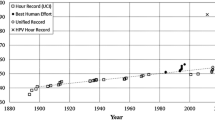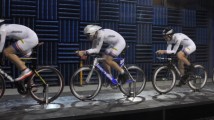Abstract
In elite cycling the resistive force is dominated by aerodynamics. Be it on the roads or in the velodrome, the sport has many examples where aerodynamics has won and lost races. Since the invention of the bicycle, engineers have strived to improve performance, often by reducing aerodynamic drag. Over the last 50 years a number of authors have presented their efforts in journals, books and magazines. This review summarises the publications that show the continued development in the aerodynamics of cycling. The review concludes by examining the shortcomings of the current understanding and making suggestions for future research and development.
Similar content being viewed by others
References
Apelt, C.J., West, G.A. & Szewczyk, A. A. (1975) The effects of wake splitter plates on, and the flow past, a circular cylinder in the range 104=Re=5104. Part 1.Journal of Fluid Mechanics,61, 187–198.
Ashley, S. (1993) Cheetah sprints to world record.American Society of Mechanical Engineers, 56–59.
Bassett, D.R.J., Kyle, C.R., Passfield, L., Broker, J.P. & Burke, E.R. (1999) Comparing cycling world hour records, 1967–1996: modeling with empirical data.Medicine & Science in Sports & Exercise,31 (11), 1665–1676.
Broker, J.P. (2003) Cycling power: Road and mountain. In:High-Tech Cycling: The Science of Riding Faster (ed. Burke, E. R.) Human Kinetics, Colorado, pp. 147–174.
Brownlie, L.W., Kyle, C.R., Harber, E., MacDonald, R. & Shorten, M.R. (2004) Reducing the aerodynamic drag of sports apparel: Development of the Nike Swift sprint running and SwiftSkin speed skating suits In:5th International Conference on the Engineering of Sport, Vol. 1 (eds. Hubbard, M., Mehta, R. D. & Pallis, J. M.) U.C. Davis, USA, pp. 91–96.
Capelli, C., Rosa, G., Butti, F., Ferretti, G., Veicsteinas, A. & di Prampero, P. (1993) Energy cost and efficiency of riding aerodynamic bicycles.European Journal of Applied Physiology,67 (1), 144–149.
Chin, K.Y. & Lim, L.K. (2001)The design of aerodynamically sound, bike’s helmet. Department of Mechanical Engineering, University of Adelaide, Adelaide.
Davies, C.T.M. (1980) Effect of air resistance on the metabolic cost and performance of cycling.European Journal of Applied Physiology & Occupational Physiology,45 (1), 245–254.
Grappe, F., Candau, R., Belli, A. & Rouillon, J.D. (1997) Aerodynamic drag in field cycling with special reference to the Obree’s position.Ergonomics,40 (12), 1299–1311.
Greenwell, D.I., Wood, N.J., Bridge, E.K L. & Addy R.J. (1995) Aerodynamic characteristics of low-drag bicycle wheels.Aeronautical Journal,99 (983), 109–120.
Gross, A.C., Kyle, C.R. & Malewicki, D.J. (1983) Aerodynamics of Human-Powered Land Vehicles.Scientific American,249 (6), 126–134.
Hagberg, J.M. & McCole, S.D. (1990) The effect of drafting and aerodynamic equipment on the energy expenditure during cycling.Cycling Science,2 (3), 19–22.
Hanna, K.R. (2002) Can CFD make a performance difference in sport? In:4th International Conference on the Engineering of Sport (eds. Ujihashi, S. & Haake, S.J.) Blackwell Science, Kyoto, Japan, pp. 17–30.
Hill, R.D. (1993) Design and development of the LotusSport pursuit bicycle.Proceedings of the Institution of Mechanical Engineers, Part D: Journal of Automobile Engineering,207 (4), 285–294.
Johnson, S.C. & Schultz, B.B. (1990) The physiological effects of aerodynamics handlebars.Cycling Science, 29–12.
Kim, I. (1990) Racers, rough riders, and recumbents.Mechanical Engineering,112 (5), 52–59.
Kyle, C.R. (1979) Reduction of wind resistance and power output of racing cyclists and runners travelling in groups.Ergonomics,22 (4), 387–397.
Kyle, C.R. (1989a) The aerodynamics of handlebars and helmets.Cycling Science,1 (1).
Kyle, C.R. (1989b) The aerodynamics of helmets and handlebars.Cycling Science 1, 122–25.
Kyle, C.R. (1990) Chain friction, windy hills and other quick calculations.Cycling Science,2 (3), 23–26.
Kyle, C.R. (1991a) New aero wheel tests.Cycling Science,3 (1), 27–30.
Kyle, C.R. (1991b) Wind tunnel tests of aero bicycles.Cycling Science,3 (1), 57–61.
Kyle, C.R. (2003) Selecting cycling equipment. In:High-Tech Cycling: The Science of Riding Faster (ed. Burke, E.R.) Human Kinetics, Colorado, pp. 1–48.
Kyle, C.R. & Brownlie, L. (2002) http://www.nike.com/nikecycling/index_flash.html.
Kyle, C.R., Brownlie, L.W., Harber, E., MacDonald, R. & Nordstrom, M. (2004) The Nike Swift Spin cycling project: Reducing the aerodynamic drag of bicycle racing clothing by using zoned fabric. In:5th International Conference on the Engineering of Sport, Vol. 1 (Eds, Hubbard, M., Mehta, R.D. & Pallis, J.M.) UC Davis, USA, pp. 118–124.
Kyle, C.R. & Burke, E.R. (1984) Improving the racing bicycle.Mechanical Engineering,106(9), 34–35.
Lukes, R.A., Hart, J.H., Chin, S.B. & Haake, S.J. (2004) The aerodynamics of mountain bicycles: The role of computational fluid dynamics. In:5th International Conference on the Engineering of Sport, Vol. 1 (Eds, Hubbard, M., Mehta, R. D. & Pallis, J. M.) U.C. Davis, U.S.A., pp. 104–110.
McCole, S.D., Claney K., Conte, J.C., Anderson, R. & Hagberg, J.M. (1990) Energy expenditure during bicycling.Journal of Applied Physiology,68 (2), 748–753.
Melton, M. (1990) The Huffy composite triton.Cycling Science,2 (3), 8–12.
Nonweiler, T. (1956)The air resistance of racing cyclists Cranfield College of Aeronautics, Cranfield.
Nonweiler, T. (1958) The work production of man; studies on racing cyclists.Journal of Physiology,141 (1), pp. 8–9.
Pons, D.J. & Vaughan, C.L. (1989) Mechanics of cycling. In:Biomechanics of Sport (ed. Vaughan, C.L.) CRC Press, pp. 289–315.
Prampero di, P.E., Cortili, G., Mognoni, P. & Saibene, F. (1979) Equation of motion of a cyclist.Journal of Applied Physiology,47 (1), 201–206.
Pugh, L.G.C.E. (1974) The relation of oxygen intake and speed in competition cycling and comparative observations on the bicycle ergometer.Journal of Physiology,241 (1), 795–808.
Richardson, R.S. & Johnson, S.C. (1994) Effect of aerodynamic handlebars on oxygen consumption while cycling at a constant speed.Ergonomics,37 (5), 859–863.
Sunter, R.J. & Sayers, A.T. (2002) Aerodynamics of mountain bike tyres. In:4th International Conference of the Engineering of Sport (eds. Ujihashi, S. & Haake, S.J.) Blackwell Science, Kyoto, Japan, pp. 63–73.
Swain, D.P., Coast, J.R., Clifford, P.S., Milliken, M.C. & Stray-Gundersen, J. (1987) Influence of body size and oxygen consumption during bicycling.Journal of Applied Physiology,62 (2), 668–672.
Tew, G.S. & Sayers, A.T. (1999) Aerodynamics of yawed racing cycle wheels.Journal of Wind Engineering & Industrial Aerodynamics,82 (1), 209–222.
Thompson, L. (1998) Engineering the world’s fastest bicycle. In:2nd International Conference on the Engineering of Sport (ed. Haake, S.J.) Blackwell Science, Sheffield, UK, pp. 99–109.
van Ingen Schenau, G.J. (1988) Cycle power: a predictive model.Endeavour,12 (1), 44–47.
Whitt, F.R. & Wilson, D.G. (1982)Bicycling Science, The Massachusetts Institute of Technology.
Zdravkovich, M.M. (1992) Aerodynamics of bicycle wheel and frame.Journal of Wind Engineering & Industrial Aerodynamics,40 (1), 55–70.
Zdravkovich, M.M., Ashcroft, M.W., Chisholm, S.J. & Hicks, N. (1996) Effect of cyclist’s posture and vacinity of another cyclist on aerodynamic drag. In:1st International Conference on the Engineering of Sport (ed. Haake, S.J.) A.A. Balkema, Sheffield, UK, pp. 21–28.
Author information
Authors and Affiliations
Corresponding author
Rights and permissions
About this article
Cite this article
Lukes, R.A., Chin, S.B. & Haake, S.J. The understanding and development of cycling aerodynamics. Sports Eng 8, 59–74 (2005). https://doi.org/10.1007/BF02844004
Issue Date:
DOI: https://doi.org/10.1007/BF02844004




